Nokia Asha 200 User Guide
Nokia 200 User Guide
Issue 1.2

2 Contents
Contents
Safety |
4 |
|
|
Get started |
5 |
Your dual SIM phone |
5 |
Keys and parts |
5 |
Insert a SIM card and battery |
6 |
Insert a second SIM card |
7 |
Charge the battery |
8 |
Switch the phone on or off |
9 |
Insert a memory card |
9 |
GSM antenna |
10 |
Connect a headset |
11 |
Attach the wrist strap |
11 |
|
|
Basic use |
11 |
Support |
11 |
Access codes |
12 |
Set which SIM card to use |
12 |
Lock the keys |
13 |
Indicators |
13 |
Copy contacts or pictures from your |
|
old phone |
14 |
Use your phone without a SIM card |
14 |
|
|
Calls |
14 |
Make a call |
14 |
View your missed calls |
15 |
Call the last dialled number |
15 |
Divert calls to your voice mailbox or |
|
another phone number |
15 |
|
|
Contacts |
16 |
Save a name and phone number |
16 |
Use speed dial |
16 |
Send your contact information |
17 |
|
|
Write text |
17 |
Write using the keyboard |
17 |
Predictive text input |
18 |
Messaging |
18 |
Send a message |
18 |
Save an attachment |
19 |
Retrieve a multimedia message |
20 |
Listen to voice messages |
20 |
Send an audio message |
20 |
Mail and chat |
21 |
About Mail |
21 |
Send a mail |
21 |
Read and reply to mail |
21 |
About Chat |
21 |
Chat with your friends |
21 |
Connectivity |
22 |
Bluetooth |
22 |
USB data cable |
24 |
|
|
Clock |
24 |
Change the time and date |
24 |
Alarm clock |
24 |
|
|
Pictures and videos |
25 |
Take a picture |
25 |
Record a video |
25 |
Send a picture or video |
26 |
Organise files |
26 |
|
|
Music and audio |
26 |
Media player |
26 |
FM radio |
27 |
|
|
Browse the web |
29 |
About the web browser |
29 |
Browse the web |
29 |
Add a bookmark |
30 |
Fit a web page to your phone display 30
Save on data costs |
31 |
Clear your browsing history |
31 |
|
|
About Social |
31 |

Contents 3
Device management |
32 |
Update device software using your |
|
device |
32 |
Update phone software using your |
|
PC |
33 |
Restore original settings |
34 |
Back up your pictures and other |
|
content to a memory card |
34 |
Protect the environment |
34 |
Save energy |
34 |
Recycle |
34 |
|
|
Product and safety information |
35 |
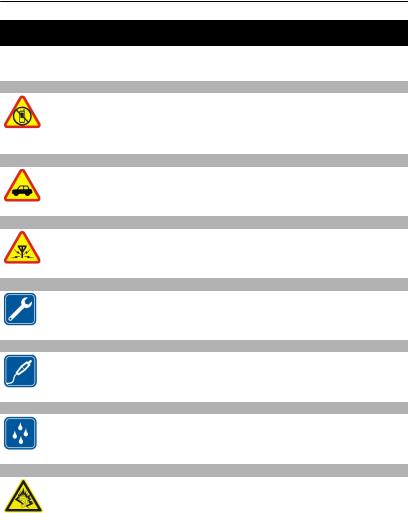
4 Safety
Safety
Read these simple guidelines. Not following them may be dangerous or illegal. For further information, read the complete user guide.
SWITCH OFF IN RESTRICTED AREAS
Switch the device off when mobile phone use is not allowed or when it may cause interference or danger, for example, in aircraft, in hospitals or near medical equipment, fuel, chemicals, or blasting areas. Obey all instructions in restricted areas.
ROAD SAFETY COMES FIRST
Obey all local laws. Always keep your hands free to operate the vehicle while driving. Your first consideration while driving should be road safety.
INTERFERENCE
All wireless devices may be susceptible to interference, which could affect performance.
QUALIFIED SERVICE
Only qualified personnel may install or repair this product.
BATTERIES, CHARGERS, AND OTHER ACCESSORIES
Use only batteries, chargers, and other accessories approved by Nokia for use with this device. Do not connect incompatible products.
KEEP YOUR DEVICE DRY
Your device is not water-resistant. Keep it dry.
PROTECT YOUR HEARING
Listen to a headset at a moderate level, and do not hold the device near your ear when the loudspeaker is in use.
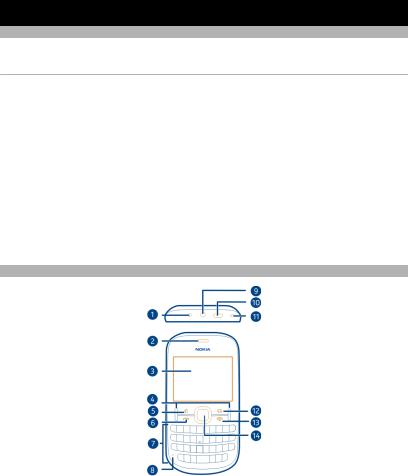
Get started |
5 |
Get started
Your dual SIM phone
You can insert two SIM cards.
Some benefits of a dual SIM phone
•You can make savings when you use services from different service providers.
•Use one phone number for personal calls and another for work, but carry only one phone.
•Avoid network coverage variation between service providers.
Both SIM cards are available at the same time when the device is not being used, but while one SIM card is active, for example, making a call, the other is unavailable.
If you only have one SIM card, insert the card into the SIM1 card holder. Some features and services may only be available when using the SIM card in the SIM1 card holder. If there is a SIM card only in the SIM2 card holder, you can only make emergency calls.
A GPRS connection cannot be open in the background. If an application is using a GPRS connection, and you return to the home screen or switch to another application, menu, or other view, the connection is automatically closed.
Keys and parts
1Charger connector
2Earpiece
3Screen
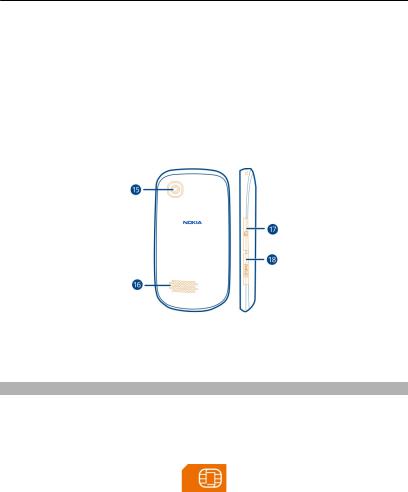
6 Get started
4Selection keys
5SIM manager key
6Call key
7Keypad
8Microphone
9Headset connector/Nokia AV connector (3.5 mm)
10Micro-USB connector
11Wrist strap hole
12Messaging key
13End/Power key
14Navi™ key (scroll key)
15Camera lens
16Loudspeaker
17Memory card slot
18SIM card slot (SIM 2)
Insert a SIM card and battery
 Important: This device is designed to be used with a standard SIM card (see figure) only. Use of incompatible SIM cards may damage the card or the device, and may corrupt data stored on the card. Please consult your mobile operator for the use of a SIM card that has a mini-UICC cutout.
Important: This device is designed to be used with a standard SIM card (see figure) only. Use of incompatible SIM cards may damage the card or the device, and may corrupt data stored on the card. Please consult your mobile operator for the use of a SIM card that has a mini-UICC cutout.
This phone is intended for use with a BL-5J battery. Always use original Nokia batteries.
If you only have one SIM card, insert the card into the internal SIM card holder.
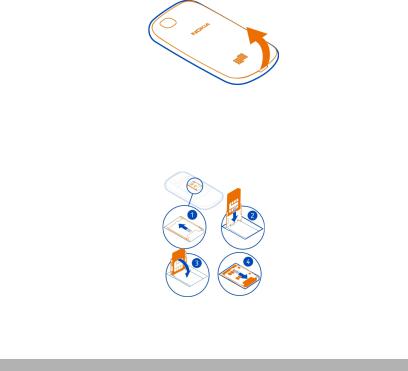
Get started |
7 |
1Place your finger in the recess at the bottom of the phone, and carefully lift and remove the back cover.
2If the battery is inserted, lift it out.
3Slide the SIM card holder to unlock it (1), and use your fingernail to lift it. Make sure the contact area would face down when the SIM card holder is lowered (2), insert the SIM card into the holder, and lower the holder (3). Slide the card holder to lock it (4).
4Line up the contacts of the battery and the battery compartment, and insert the battery. To replace the back cover, direct the top locking catches toward their slots, and press down until the cover locks into place.
Insert a second SIM card
Have a second SIM card, but want to keep using your main SIM card? You can insert or remove a second SIM card without switching the phone off.
1Open the cover of the external SIM card slot, marked with  .
.
2Make sure the contact area of the SIM card is facing up, and insert the card. Push the card in, until it locks into place.
3Close the cover.
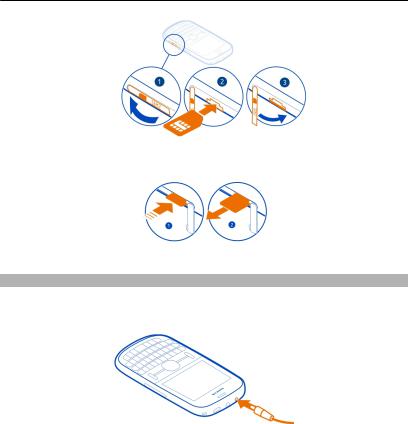
8 Get started
Remove the second SIM card
Charge the battery
Your battery has been partially charged at the factory, but you may need to recharge it before you can switch on your phone for the first time. If the phone indicates a low charge, do the following:
1Connect the charger to a wall outlet.
2Connect the charger to the phone.
3When the phone indicates a full charge, disconnect the charger from the phone, then from the wall outlet.
You do not need to charge the battery for a specific length of time, and you can use the phone while it is charging.
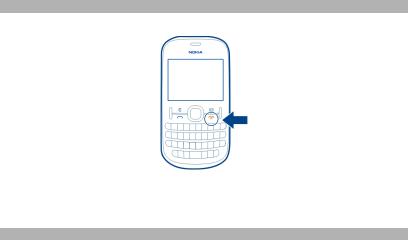
Get started |
9 |
If the battery is completely discharged, it may take several minutes before the charging indicator is displayed or before any calls can be made.
If the battery has not been used for a long time, to begin charging, you may need to connect the charger, then disconnect and reconnect it.
Switch the phone on or off
Press and hold the power key  until the phone vibrates.
until the phone vibrates.
You may be prompted to get the configuration settings from your network service provider. For more information on this network service, contact your network service provider.
Insert a memory card
Use only compatible memory cards approved by Nokia for use with this device. Incompatible cards may damage the card and the device and corrupt data stored on the card.
Your phone supports memory cards with a capacity of up to 32 GB.
1Open the cover of the memory card slot.
2Make sure the contact area of the memory card is facing up, and insert the card. Push the card in, until it locks into place.
3Close the cover of the memory card slot.
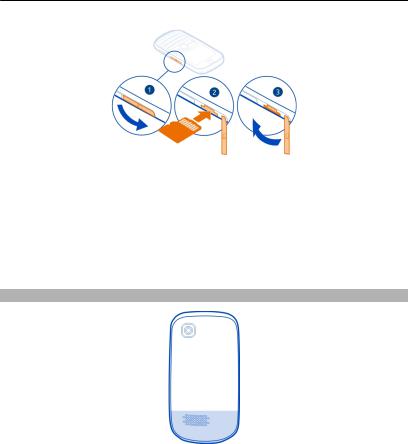
10 Get started
 Important: Do not remove the memory card when an application is using it. Doing so may damage the memory card and the device and corrupt data stored on the card.
Important: Do not remove the memory card when an application is using it. Doing so may damage the memory card and the device and corrupt data stored on the card.
You can remove or replace the memory card without switching the phone off.
Remove the memory card
Push the card in, until it is released, and pull the card out.
GSM antenna
The antenna area is highlighted.
Avoid touching the antenna area while the antenna is in use. Contact with antennas affects the communication quality and may reduce battery life due to higher power level during operation.
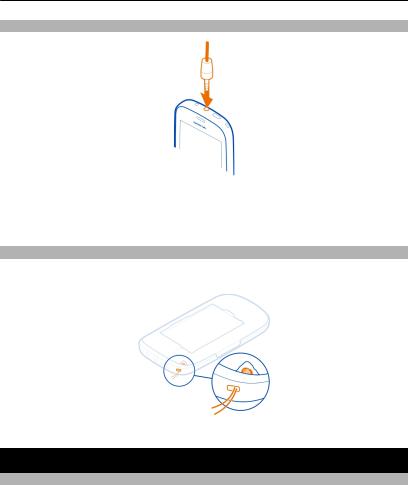
Basic use 11
Connect a headset
Do not connect products that create an output signal, as this may damage the device. Do not connect any voltage source to the Nokia AV connector. If you connect an external device or headset, other than those approved by Nokia for use with this device, to the Nokia AV connector, pay special attention to volume levels.
Attach the wrist strap
Remove the back cover, thread the strap through the hole, and loop the strap around the wrist strap peg.
Wrist straps may be available separately.
Basic use
Support
When you want to learn more about how to use your phone, or if you're unsure how your phone should work, read the user guide thoroughly.
If you have an issue, do the following:

12 Basic use
•Reboot your phone. Switch off the phone, and remove the battery. After about a minute, replace the battery, and switch on the phone.
•Update your phone software
•Restore the original factory settings
If your issue remains unsolved, contact Nokia for repair options. Go to www.nokia.com/repair. Before sending your phone for repair, always back up your data, as all personal data in your phone may be deleted.
Access codes
The security code helps to protect your phone against unauthorised use. You can create and change the code, and set the phone to request the code. Keep the code secret and in a safe place separate from your phone. If you forget the code and your phone is locked, your phone will require service. Additional charges may apply, and all the personal data in your phone may be deleted. For more information, contact a Nokia Care point or your phone dealer.
The PIN code supplied with the SIM card protects the card against unauthorised use. The PIN2 code supplied with some SIM cards is required to access certain services. If you enter the PIN or PIN2 code incorrectly three times in succession, you are asked for the PUK or PUK2 code. If you do not have them, contact your service provider.
The module PIN is required to access the information in the security module of your SIM card. The signing PIN may be required for the digital signature. The barring password is required when using the call barring service.
To set how your phone uses the access codes and security settings, select Menu >
Settings >Security.
Set which SIM card to use
You can set which SIM card to use for outgoing calls or messages. If you name your SIM cards, you can see at a glance which is, for example, for work and which is for personal use.
Press the SIM manager key. Select SIM1 or SIM2.
To be prompted to select a SIM card before, for example, making a call or sending a text message, select Ask every time.
Rename a SIM card Select Options >Rename.
